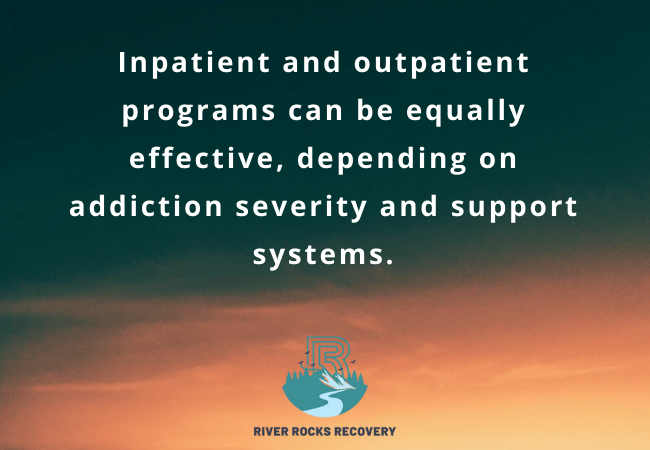When you or a loved one is facing the life-altering challenge of addiction, choosing the right treatment approach is one of the most important decisions you’ll make. One of the first questions people often ask is: Should I go to inpatient rehab or choose outpatient care?
At River Rocks Recovery, we help individuals and families across Ohio navigate this very question every day. With a full range of services—including Outpatient Program in Ohio, Intensive Outpatient Program in Ohio, and Partial Hospitalization Program in Ohio—we believe in matching each person with the level of care that best supports their recovery.
This comprehensive guide breaks down the key differences between inpatient and outpatient drug rehab, including pros, cons, real-world examples, and guidance based on your personal circumstances.
What’s the Difference Between Inpatient and Outpatient Drug Rehab?
Understanding these two models of care is essential for making an informed choice.
Inpatient Drug Rehab (Residential Treatment)
Inpatient rehab involves living at a treatment facility for the duration of your program. This immersive environment provides round-the-clock medical care, supervision, and therapeutic support. Stays usually last from 30 to 90 days or longer, depending on the severity of addiction.
Outpatient Drug Rehab
In outpatient rehab, clients live at home and travel to a treatment center several times per week. Treatment may include therapy, medication management, group sessions, and relapse prevention planning. It offers flexibility for those with work, family, or school commitments.
Both forms of care are widely available through certified Addiction Treatment Programs in Ohio, and many individuals benefit from moving between them during their recovery.
Inpatient Drug Rehab: Deep Dive into the Pros and Cons
Pros of Inpatient Rehab
1. 24/7 Structure and Supervision
In inpatient rehab, you’re surrounded by trained staff at all times. This ensures immediate help in medical or emotional crises and keeps clients focused on recovery.
2. Safe and Controlled Environment
Inpatient settings eliminate access to drugs and alcohol, reducing the risk of early relapse during the most vulnerable phase of recovery.
3. Intensive Focus on Healing
Without daily life distractions, clients can dedicate 100% of their energy to recovery, trauma processing, and mental health support.
4. Detox and Medical Support
For clients in Opiate Rehab Treatment in Ohio or Meth Rehab Treatment in Ohio, withdrawal symptoms can be dangerous. Inpatient settings offer medical detox and medication-assisted treatment (MAT).
5. Ideal for Dual Diagnosis
Clients with co-occurring mental health disorders benefit from psychiatric care integrated into the rehab process.
Cons of Inpatient Rehab
1. Time Commitment
Programs require you to stay onsite, which can be difficult for parents, caregivers, or those with job obligations.
2. Cost
Inpatient rehab can be more expensive than outpatient care due to housing, meals, and 24-hour staffing, although many insurance plans cover these services.
3. Challenging Transition
Reentering daily life after inpatient rehab can be a shock. Without step-down care like Intensive Outpatient Program in Ohio, the risk of relapse increases.
Outpatient Drug Rehab: Deep Dive into the Pros and Cons
Pros of Outpatient Rehab
1. Flexibility for Real Life
Clients can continue working, going to school, or caring for loved ones while still receiving structured support.
2. Lower Cost
Since outpatient clients do not reside at the facility, treatment costs are significantly lower, making it more accessible for those on tight budgets or with limited insurance coverage.
3. Apply Recovery Skills Immediately
Because clients stay in their real-world environments, they can practice and refine coping skills, problem-solving, and boundary-setting in real-time.
4. Strong Support Network Access
Clients stay close to family and friends, which can be beneficial if those relationships are healthy and supportive.
5. Step-Down Continuity
Outpatient care is often used after inpatient treatment to reinforce progress. Our Partial Hospitalization Program in Ohio and IOP provide this transitional support.
Cons of Outpatient Rehab
1. More Exposure to Triggers
Returning home each night can mean facing the same people, places, or circumstances that contributed to the addiction.
2. Requires Strong Motivation
Outpatient clients need to show up consistently and apply what they learn—there is more personal accountability involved.
3. Not Always Ideal for Severe Addiction
Individuals with long-term substance abuse or unstable living environments may need the more controlled setting of inpatient care to stabilize.
Inpatient vs. Outpatient: Comparison Table
| Criteria | Inpatient Rehab | Outpatient Rehab |
|---|---|---|
| Living Arrangement | Onsite, 24/7 facility care | Live at home, commute to treatment |
| Best For | Severe or long-term addiction | Mild/moderate addiction, or step-down care |
| Supervision | 24/7 medical and emotional support | Regular monitoring during visits |
| Cost | Higher (includes room/board) | Lower (no overnight stay) |
| Flexibility | Minimal (requires full commitment) | High (works with job, school, family) |
| Family Involvement | Limited during treatment | Stronger due to proximity |
| Transition Back to Life | Can be abrupt if no aftercare is arranged | Gradual, real-world integration |
Step-Down Care: Combining Inpatient and Outpatient Treatment
Many individuals benefit from starting with inpatient rehab and transitioning into outpatient care as they gain stability.
Example Timeline:
-
Inpatient Detox (5–10 days)
-
Inpatient Rehab (Residential) – 30–60 days
-
PHP in Ohio – 3–4 weeks of structured therapy
-
IOP in Ohio – Flexible care, building independence
-
Outpatient Program in Ohio – Long-term support, relapse prevention
-
Alumni Support – Continued connection, purpose, and guidance
This continuum of care, offered by River Rocks Recovery, provides the most comprehensive path to lasting recovery.
Why Choose Drug Rehab in Ohio?
Staying close to home has major benefits:
-
Family and friend support during outpatient treatment
-
Smooth transitions from one level of care to another
-
Familiar environment for reintegration after inpatient care
-
Community-based aftercare resources and local recovery groups
Our Addiction Treatment Center in Ohio ensures clients never feel isolated in their journey.
How River Rocks Recovery Helps You Choose the Right Path
We don’t just offer programs—we offer personalized treatment journeys. Our experienced admissions team provides:
-
Clinical assessments to determine the right level of care
-
Customized treatment plans based on your medical, emotional, and social needs
-
Step-down support to move seamlessly between inpatient and outpatient care
-
Aftercare planning to ensure continued success long after your program ends
Whether you’re seeking Opiate Rehab Treatment in Ohio, Meth Rehab Treatment in Ohio, or need help determining where to start, we’re here to guide you.
Conclusion
Choosing between inpatient and outpatient rehab may feel overwhelming, but you don’t have to make the decision alone. The most important thing is that you’re ready to take a step toward healing—and that step starts here.
At River Rocks Recovery, we offer individualized, compassionate, and evidence-based care at every level—from intensive inpatient-style day programs to flexible outpatient therapy. Whether you need full-time support or care that fits into your daily life, we’re here to walk alongside you. Call our admissions team today at 888-905-6281 to schedule a confidential assessment. Let us help you find the path to recovery that’s right for you—and build a future free from addiction.
FAQ on Inpatient vs. Outpatient Drug Rehab
What is the difference between inpatient and outpatient drug rehab?
Inpatient rehab involves living at a treatment center full-time, with 24/7 care. Outpatient rehab allows clients to live at home and attend scheduled treatment sessions while continuing daily responsibilities.
Which is better: inpatient or outpatient rehab?
Neither is “better”—it depends on your needs. Inpatient rehab is ideal for severe addictions and dual diagnosis cases. Outpatient rehab is effective for those with stable home environments and mild to moderate addiction.
Does outpatient rehab work for opioid or meth addiction?
Yes. At River Rocks Recovery, we offer Opiate Rehab Treatment in Ohio and Meth Rehab Treatment in Ohio through our outpatient programs, including PHP and IOP. These programs are supported by MAT, therapy, and medical care.
Can I work or attend school while in outpatient rehab?
Absolutely. Our Intensive Outpatient Program in Ohio (IOP) and Outpatient Program in Ohio (OP) are designed for individuals who need flexible schedules to balance treatment with personal responsibilities.
Does River Rocks Recovery offer both inpatient and outpatient care?
We specialize in outpatient levels of care (PHP, IOP, OP) and coordinate with inpatient and detox facilities when a higher level of care is needed. Our team will help you determine the right fit through a thorough clinical assessment.





























